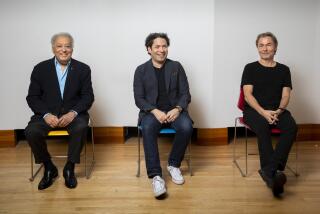Philadanco’s big gambles pay off
- Share via
Something about the steely resolve and daredevil pliability of Philadanco dancers makes you wonder just how much high-gear dancing can occur before a blowout. In a four-part program on Friday night at the Irvine Barclay Theatre, a few dancers arched back with such vigor, or flung a leg high with such force, they nearly capsized.
But that commitment to clarity and attack is what makes every work they do impressive on some level, even when it takes you on less of a journey than desired.
In “Echoes: A Celebration of Alvin Ailey” (2000), by Milton Myers, the quality of John Adams’ tense, churning score seemed to clash with the dancers’ exultant smiles as they charged on and off, sometimes coming together in an Ailey-esque tableau, with electrified arms in the air.
In an excerpt from Ronald K. Brown’s “Gate Keepers” (2000), calm alternated with bursts of dense movement phrases that functioned a bit like conversation. Performers sometimes danced “at” each other, halting suddenly or speeding up into spins, swivels and leaps that flowed together seamlessly.
Each work seemed most riveting when these virtuosic solos or high-powered duets and trios took focus. The same was true of Christopher Huggins’ “Enemy Behind the Gates” (2002), a Southern California premiere, danced to an unidentified composition by Steve Reich.
Military-style tunics, stern verticality and straight lines set a menacing mood, but an enemy didn’t really seem like the point when defiant stances gave way to elegantly wheeling arms and rocket-launched extensions.
How do you tell beautiful display from evil posturing? The Reich score provided its own hills and dales, and again, the results felt impressive without saying much.
On the other hand, Jawole Willa Jo Zollar’s previously reviewed “Hand Singing Song” (2001) spoke volumes, exploring cool gesture in a unique voice that deftly combined the humorous with the significant.
More to Read
The biggest entertainment stories
Get our big stories about Hollywood, film, television, music, arts, culture and more right in your inbox as soon as they publish.
You may occasionally receive promotional content from the Los Angeles Times.










